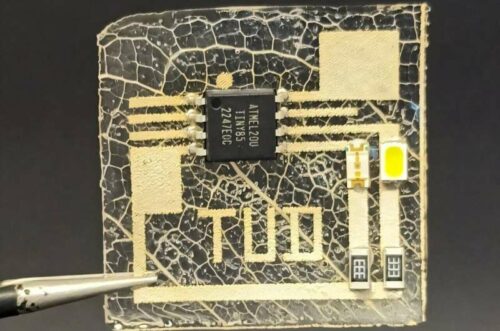Researchers in Dresden create biodegradable substrates for sustainable electronics showcasing an alternative to non-renewable electronics.

A research team at TU Dresden University of Technology, Germany led by Prof. Karl Leo, has developed a technique in sustainable electronics by creating “Leaftronics.” By drawing inspiration from the structure of natural leaves, these biodegradable electronic substrates aim to tackle the escalating problem of e-waste. The outcome presents a scalable and efficient alternative to conventional non-recyclable materials used in electronics.
The electronic industry predominantly uses printed circuit boards (PCBs) made from glass fibre-reinforced epoxy resin, which are neither recyclable nor biodegradable. With over 60 million tons of electronic waste generated annually out of which 75% remains uncollected indicates the need for environmentally friendly solutions is urgent. While previous attempts to create biodegradable polymers faced challenges with heat resistance and chemical stability, Leaftronics overcame these limitations.
The development holds particular appeal for industries such as consumer electronics, renewable energy, and advanced research facilities requiring high-performance yet sustainable solutions. Companies striving to meet environmental regulations and those pursuing greener manufacturing practices are likely to benefit from this innovation. Additionally, researchers working on circular economy models or biodegradable materials may find this technology pivotal for future projects.
The breakthrough stems from the adaptation of quasi-fractal lignocellulose structures found in natural leaves. These structures, which provide mechanical strength to leaves, have been successfully integrated into polymer films, making them both stable at high temperatures and environmentally degradable. “We were surprised to find that these natural skeletons can stabilise polymers thermomechanically without compromising their biodegradability,” said Dr. Hans Kleemann, leader of the organic devices and Systems group.
These newly developed electronics not only reduces the carbon footprint by being three times more sustainable than paper-based substrates but also offers an environmentally friendly disposal method. After use, these substrates decompose easily, facilitating the recovery of valuable materials.
As industries worldwide pursue greener technologies, Leaftronics showcases the potential of merging nature and technology. Prof. Karl Leo describes it as “a promising fusion for a circular economy in electronics, offering hope for a more sustainable future.”









